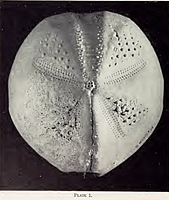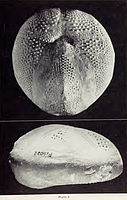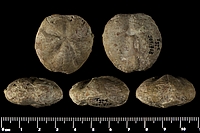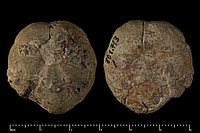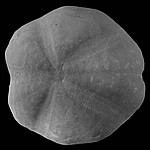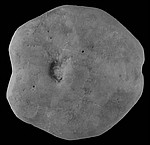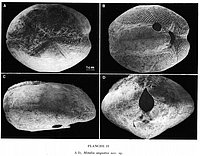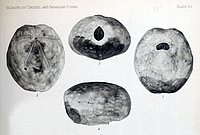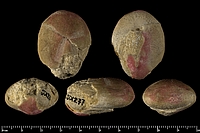|
Brissidae
Gray, 1855
nomen transl.
Lambert, 1901, p.969 (Brissina
Gray, 1855, p.49)
Genre type : Brissus,
Gray, 1825, p.431
Description succincte de la famille :
Fasciole sub-anal et péripétale. Système apical ethmophracte à ethmolytique.
Deux à quatre gonopores.
|
|

 |
|
 |
| |
|
|
Genre
Brissus
Gray, 1825
An attempt to divide
sea eggs, p.431
Espèce type
Spatangus brissus unicolor Leske,1778
par
décision de l'ICZN, 1948
Extension
stratigraphique (bibliographique,
non vérifiée) : Eocène
- Actuel
Syn.
-
Bryssus
Martens, 1862 ; homonyme ;
-
Allobrissus
Mortensen, 1950 ; espèce
type Brissus agassizi
Doderlein, 1855 ; synonyme subjectif plus récent
-
Sandiegoaster
Sanchez Roig, 1952 ; espèce
type Sandiegoaster durhami
Sanchez Roig, 1952 ; synonyme subjectif plus récent
|
|
|
| |
|
diagnose du genre
par Gray, 1825 |
|
An attempt to
divide sea eggs, p. 423 |
| |
|
Brissus, Klein.
Nuces, Van Phel.
Body ovate ; ambulacra four, the hinder wanting, ail surrounded
by a. groove.
*B. ventricosus, Leske. Klein, t. 26, f. A.;
unicolor, Leske.
Klein, t. 26, f. B C. **B. carinatus, Leske, t. 48, f.
4, 5. Seba, iii. t. 14, f. 3, 4. B. colunabaris,
Seba, iii,t. 10, f. 19. |
|
| |
|
 |
| |
| |
Brissus agassizii
DÖderlein, 1885 |
|
|
| |
|
diagnose originale de
l'espèce par Döderlein, 1885 |
|
Seeigel von Japan und den Liu-Kiu Inseln,
p.108 |
| |
|
44. Brissus Agassizii n. sp.
Der Hinterrand der Schale
fällt gerade ab und ist von oben betrachtet leicht eingebuchtet. Der
Wirbel der Schale liegt unmittelbar hinter dem Apicalfelde, das selbst
in einer Vertiefung liegt.
Der
affallendste Charakter besteht in der bedeutenden Länge des hinteren
seitlichen Ambulacren, die viel (über ein Drittel) länger sind als das
vordere Paar. Dieselben kommen dem Hinterrande der Schale auch viel
näher als bei den anderen Arten der Gattung, indem ihre Entfernung von
demselben weniger beträgt als di Hälfte ihrer Länge. Das letzte
Drittel der paarigen Ambulacren ist leicht nach aussen resp. nach vorn
gebogen.
Die
peripetale Fasciole ist sehr stark winklig une begleitet den Rand der
Ambulacralblätter auf etwa zwei Drittel ihrer Länge, nur den
Vorderrand der vorderen Ambulacren zur Hälfte.
Beim
Durchkreuzen der vorderen paarigen Interambulacralräume macht die
peripetale Fasciole auf der rechten Seite zwei, auf der linken nur
einen einspringenden Winkel bei den beiden mir vorliegenden Exemplaren.
Die
subanale Area ist so breit oder schmäler als das Aktinalfeld, umgeben
von einer schmalen aber sehr scharfen Fasciole, die sich etwa bis zur
Höhe des Analfeldes erhebt, unter demselben aber seh tief eingebuchtet
ist.
Die
Oberseite der Schale ist mit gleichmässig kleinen Tuberkeln besät, bis
auf das vordere Drittel, wo dieselben viel gröber sind, fast so gross
wie im vorderen Drittel der Unterseite.
Ich erhielt
zwei Exemplare von 98mm un von 72mm Länge durch Fischer in Enoshima,
das eine war noch mit dunkelbraunen Stacheln bedeckt. |
|
| |
|
description de
l'espèce par Baker, 1967 |
|
Two new echinoids from Northern New Zealand,
including a New Species of Diadema |
| |
|
Brissus (Allobrissus) agassizii Döderlein
(Pl. 3)
Material Examined :
23/5/65, Tawhitirahi Island, Poor Knights Islands, 174° 44' E,
35° 28' S, 250ft, one denuded specimen collected by Mr W. Palmer. June
7, 1965, Poor Knights Islands, 80ft, one perfect specimen collected by
Mr W. Doak. Both specimens are lodged in the Dominion Museum,
Wellington (Ech. 1000).
Test ovoid,
anterior margin smoothly rounded, no frontal depression. Aboral side
arched, posterior interamb carinate. Oral side convex, carinate
posteriorly.
Paired ambs
petaloid, slightly divergent. Frontal amb flush, pore paires united
into narrow vertical slits. Anterior petals laterally directed, durved
anteriorly distally. Antero-lateral ambs strongly developed adorally
forming a phyllode. Adoral postero-lateral ambs narrow and
conspicuously naked.
Peristome
anterior, directly beneath apical system, broadly crescentic. Labrum
tuberculate, deflected slightly downward. Madreporite lenticular.
Posterior
end of test vertically truncate, slightly concave, Periproct oval,
pointed above and below, aboral margin visible from above. Subanal
plastron wide and reniform. Sternal plastron large, convex and
carinate posteriorly.
Radioles
short and dense ; spade-shaped on sternal plastron. Globiferous
pedicellariae with curved valves terminating in a slit bordered by six
long teeth. Tridentate pedicellariae of two kinds : one with long
narrow valves strongly dentate in the lower part and expanded into a
spoon-shaped blade distally ; the other with small, pointed valves.
Typical rostrate, ophicephalus, and triphyllous pedicellariae present.
Test with
radioles light brown; denuded test uniform cream.
planche 3
|
|
| |
|
spécimen figuré sur
www.portphillipmarinelife.net.au |
|
Miskelly, A., 2011, Sea Urchin, Brissus agassizii,
in Taxonomic Toolkit for marine life of Port Phillip Bay, Museum Victoria,
accessed 07 May 2021,
http://136.154.202.208:8098/species/7728
Accessed 06 May 2021 (license CC BY, rights
seaurchins.com.au) |
| |
|
|
| |
| |
Brissus agassizii
DÖderlein, 1885
- Actuel, Philippines. Caubian Island. 67 mm
prélevé à 15cm
dans le substrat à 12 m de profondeur, pêcheur local |
|
|
| |
|
|
| |
|
 |
| |
| |
Brissus
latecarinatus (Leske,1778) |
|
|
| |
|
diagnose originale
de l'espèce par Leske, 1778 |
|
Additamenta ad
iacobi theodori Klein naturalem dispositionem echinodermatum |
| |
|
Species X. Spatangites carinatus.
Tab. LI. fig. 2. 3.
Similis eft praecedenti : at extremitas pofterior f. analis
integra, angufta; tefta eft cordata, et dorfum in medio carihatum
Ambulacra quina,vt in praecedente fpecie ex duobus punctis
oriuntur, atquelinea recta connectuntur. In finu feries
pororum obfoleta duplex defcendit. Reliqua ambulacra eminentes
ftriarum binas feries habent, quae poris; materia lapidea repletis,
ortae funt. Bafis media parte verfus anum convexa, circa os
impreffa. Os reniforme fuit. Anus in ipfo margine
extremiratis anguflioris obfolete tantum confpicitur. Nucleum
itaque calcareum, tefta pluribus locis privatum, icon exhibet.
Reperitur in mufeo Linkiano. Coloris en flauefcente
cinerei.
BAIEP. oryct. noric. tab.III. f. 43.
Echinites cordatus, fpecimini noftro omninofimilis.
VALENTIN. muf. Il. tab. II. f. 7. no. 1.
iconem eandem repetit. |
|
| |
|
description de
l'espèce par Clark, 1917 |
|
Hawaian and other Pacific echini, p.209 |
| |
|
Brissus latecarinatus.
Spatangus brissus var. latecarinatus, Leske, 1778. Add.
ad Klein, p. xx, 185.
Brissus carinatus Gray, 1825. Ann. Phil., 26, p. 431.
Plate 146, fig. 15.
This is the Indo-Pacific species of the genus and its
wide range extends as far as Panama. It is true that Verrill described
the Panamic species as obesus and Mr. Agassiz accepted this
third form of Brissus in the Revision. But he clearly expresses doubt
as to its validity, and I find myself unable to distinguish specimens
from Panama from those of the same size from various Pacific Islands
and even from Mauritius. Indeed, the characters of the fasciole and
petals mentioned in the Revision as distinguishing the Atlantic from
the Pacific species do not seem to be at all constant.
The pedicellariae are in
general similar to those of the Atlantic species. Globiferous seem to
be very rare but are usually present on or near the periproct; the
valves are about half a millimeter long and closely resemble those of
brissus. Rostrate pedicellariae, with valves like those of brissus,
.60-.85 mm. long, are more common. Large tridentate pedicellariae are
present on the periproct and on the ambulacra ventrally; the valves,
which measure .37-1.75 mm., have a lower, wider apophysis and much
longer teeth on the margins of the blade than in brissus; the marginal
teeth may be one fifteenth of the length of the valve. These large
characteristic pedicellariae were practically wanting on a small
specimen but on the other hand, the small specimen had ophicephalous
pedicellariae, which were quite lacking in the large individual
examined; these pedicellariae are like those of brissus and the
valves are about .20 mm. long with a loop .05-. 10 mm. in addition.
Besides the large tridentate pedicellariae, there is a very
characteristic form of tridentate found on both specimens, near the
mouth and on the posterior ambulacra just above the ambitus. In this
form, the valves (PL 146, fig. 15) .60-.80 mm. long, are slender,
strongly compressed, with very thick, slightly serrate margins. They
are thus very
markedly different from the corresponding slender tridentate
pedicellariae of brissus. I found no triphyllous pedicellariae
on either of the examined specimens.
The
Albatross collection
contains half a dozen specimens, of which three are from an unknown
locality; the largest is a bare test 165 mm. long. There is one small
specimen from Laysan, H. I., and another only 9 mm. long from near
Modu Manu, H. I., 26 fms. In this last the generic characters are very
distinct but the specific characters are those of brissus. A slightly
larger specimen 19 mm. long, from the Gulf of California, 7 fms. shows
the beginning of the dorsal keel in interambulacrum 5 but the
posterior end of the test is still vertical, as in brissus.
Planche 146 (extrait)
|
|
| |
| |
Brissus
latecarinatus (Leske,1778)
- Actuel, Philippines. reef of Caubian Island. 56.6 mm
prélevé à 2 m de profondeur, pêcheur local |
|
|
| |
|
|
| |
| |
Brissus
latecarinatus (Leske,1778)
-
Pléistocène, Hurghada, Egypte, 50 mm |
|
|
| |
|
|
| |
|
 |
| |
| |
Brissus
gregoryi Stefanini |
|
|
| |
| |
Brissus
gregoryi Stefanini -
Upper Coralline Limestone, Gozo, Malte, 34 mm |
|
|
| |
|
|
| |
|
 |
| |
| |
Brissus jacquemeti
Lambert,1910 |
|
|
| |
|
diagnose originale de
l'espèce par Lambert,1910 |
|
Description des
échinides néogènes du bassin du Rhône, p.179 |
| |
|
Brissus Jacquemeti
Lambert.
(Pl. XIV,
ftg. 14, 16.)
Espèce de petite taille, mesurant 25mm de longueur sur 16 de largeur,
et 16 de hauteur, remarquablement allongée, étroite, cylindrique,
progressivement rétrécie et subtronquée en arrière, arrondie en avant
; apex très excentrique en avant ; pétales pairs peu déprimés, longs,
étroits, très inégaux, les antérieurs courts très divergents et même
un peu retournés en arrière, les postérieurs très longs, très peu
divergents, ayant cependant leiir extrémité assez éloignée du
périprocte ; face postérieure étroite, obliquement tronquée.
M. Cottreau, qui, au lieu de multiplier les espèces, préfère les
réunir, ce dont je suis loin de lui faire un reproche, a voulu
rattacher ce Brissus au B. Bastia Oppenheim du Stampien.
Il me semble avoir en cela un peu dépassé la mesure. Il suffit, en
effet, de jeter un coup d'oeil sur les figures 4 de sa pl. XV pour
reconnaître que la figure grossie e représente un individu faiblement
inéquipétale, à fasciole peu, sinueux, certainement différent de celui
figure 4, très inéquipétale, plus étroit, avec pétales étroits,
superficiels. Le premier n'est certainement pas le B. Bastia
tel que l'a compris et figuré Oppenheim (Revision der tert. Echin.
Venetiens und des Trentino, p. 261, fig. 21), et il est également sans
rapports avec mon B. Jacquemeti. Quant au second, avec sa forme
plus, dilatée en arrière, ses pétales plus superficiels, les
antérieurs encore plus divergents, son identité avec le B. Bastia
me semble éminemment douteuse; il me paraît, au contraire, inséparable
du B. Jacquemeti. Ce dernier diffère du type du B. Bastia du
Monte Bastia par sa forme plus allongée, plus cylindrique, plus
rétrécie en arrière, ses pétales |
|
postérieurs
moins longs, les antérieurs dirigés en arrière. Brissus Bastia semble
d'ailleurs dépourvu de fasciole sous-anal et rentrer dans le genre
Cestobrissus. B. dilatatus Desor, du Calcaire à Astéries de
la Gironde, est bien plus large, moins cylindrique, plus ovalaire. Le
B. Jacquemeti ne me paraît d'ailleurs pouvoir être confondu
avec aucun de ses congénères.
Localités. Sausset
(Bouches-du-Rhône); étage Langhien. M. Cottreau cite l'espèce au Cap
de Nantes, entre Carry et Le Rouet, dans des couches à Parasalenia
Fontanesi qu'il attribue à l'Aquitanien. Un autre individu, d'autre
part, a été recueilli à Villeneuve-les-Avignon (Gard), au gisement de
la Femme-de-Loth, avec Terebratulina calattiscus, dans des
couches qui se rattachent aux marnes voisines du Schlier. L'espèce
passerait donc du Néogène le plus inférieur jusqu'à la base de
l'Helvétien. Coll. Faculté des Sciences de Lyon, Jacquemet.
Extrait de la
planche II, fig. 19-22
|
|
| |
| |
Brissus jacquemeti
Lambert,1910 - Miocène moyen, Termopil, Ukraine, 44 mm |
|
|
| |
|
|
| |
|
 |
| |
|
|
Genre
Gillechinus
Fell,1964
New Genera of tertiary
Echinoids from Victoria, australia, p.213
Espèce type
Gillechinus cudmorei Fell,1964
par
désignation originale
Extension
stratigraphique (bibliographique,
non vérifiée) : Eocène sup.
- Miocène inf. |
|
|
| |
|
diagnose du genre par
Fell, 1964 |
|
New genera of
tertiary echinoids from Victoria, Australia, p.3 [213] |
| |
|
GILLECHINUS
gen. nov.
Test of ovoid outline, convex above and below, of
moderate size; apex subeentral, slightly anterior; peristome
crescentic, anterior; periproct vertically ovate, placed on the
vertically truncate posterior margin of the text; vertex posterior. A
peripetalous fasciole, not cutting the petals, and a subanal fasciole,
transversely reniform; no anal fascioles. Apical system ethmolytic,
four genital pores. Frontal ambulacrum very shallow, frontal notch
very faint. Paired petals somewhat depressed, extending more than
midway to the ambitus. Interambs all somewhat inflated above, the
paired interambs carrying a conspicuous group of primary tubercles on
each posterior column
of plates, the primary tubercles confined within the peripetalous
fasciole; no primary tubercles on the posterior interamb. Plastron
completely tuberculated. the tubercles arranged in a fan-like group of
lines radiating from the posterior keel of the plastron.
Type species: G. cudmorei.
|
|
| |
|
 |
| |
| |
Gillechinus cudmorei
Fell,1964 |
|
|
| |
|
diagnose originala de
l'espèce par Fell, 1964 |
|
New genera of
tertiary echinoids from Victoria, Australia, p.3 [213] |
| |
|
Gillechinus cudrnorei sp.
nov.
Plates 2 and 3.
Dimensions of holotypc: Height, 30 mm.; length, 55 mm.;
breadth 51 mm. Ambulacra : the petals are well developed, only the
adapical 4-6 pore-pairs rudimentary, both series equally developed in
each petal the petals scarcely closing distally. There are twenty
fully-developed (plus several rudimentary adapical) pore-pairs m eaeh
series of the anterior petals, and about nineteen fullydeveloped (plus
several rudimentary adapical) pore-pairs in each series of the
posterior petals. The pores are feebly conjugate, mainly because the
distal margin of each amb-plate is slightly depressed There is no
ridge between successive pore-pairs, instead a broad, flattened
rectangular area on which several small miliary tubercles occur,
in an irregular transverse scries live to seven, with occasionally a
secondary tubercle among them. The pores of the inner and outer series
of both anterior and posterior petals are sub-equal. The peripetalous
fasciole passes just distal to the ends of the petals; it is narrow,
and rather indistinct over parts of its course, but reaches to the
anterior ambulacrum.
Interambulacra : Fine secondary tubercles are scattered
rather evenly over the whole aboral surface, but the enlarged primary
tubercles of the paired interambs are so conspicuous as to make the
rest of the surface appear relatively naked. There are about twenty
primaries in the anterior interamb, all restricted to the posterior
column of plates within the peripetalous fasciole; in the same
relative position in the posterior paired interamb occur some 22
primaries. The primaries are arranged in several series parallel to
the transverse axes of the plates which bear them, and in each row the
anterior members are smaller than the posterior.
Apical system and subanal plastron and fasciole: as in
the generic diagnosis.
Peristome, periproct and plastron all broken in holotype (see however
paratypes mentioned below). Spines unknown.
Holotype : Specimen P16022 in the collection of the
National Museum of Victoria.
Locality: Lower beds, Aldinga, South Australia, coll.
F. A. Cudmore.
Horizon: About upper Eocene (Glaessner).
Paratypes: Two specimens from the type locality. One of
these (P16023) is a complete test, but has lost the characteristic
sculpture of the upper surface. It shows however that the periproct is
vertically ovate, placed in a slightly depressed area on the
vertically truncate posterior margin of the test, and that no trace of
anal fascioles occurs (the holotype is well-enough preserved in this
region to prove the absence of anal fascioles) ; and that the
peristome is transversely crescentic, the plastron being fully
tuberculated. The paratype P16023 is illustrated in Plate 3 ; it
measures, length 48 mm. ; breadth 46 mm., and height at vertex 26 mm.
A third specimen (P16021) is incomplete, but suffices to show that the
species reached a larger size than the holotype, perhaps half as large
again (though no precise measurements can be given).
Remarks:
In Mortensen's (1951) Monograph, this material has no place in the key
to genera, since only Eupatagus matches the genus; but this
latter differs from Eupatagus in several respects, notably in the
arrangement of the primary tubercles, which are like those of
Plagiobrissus, and in the indistinct closure of the petals. The
whole aspect of Gillechinus matches that of Plagiobrissus,
not Eupatagus, yet it differs markedly from Plagiobrissus
in the complete absence of the anal fascioles, in the conspicuous
breadth of the posterior ambs on the oral side, and in the bilobed
reniform subanal plastron (which is shield-shaped, and not bilobed, in
Plagiobrissus). Gillechinus is unknown outside Australia,
though some superficially similar Tertiary species occur in New
Zealand; these latter species, however, have an internal fasciole, and
cannot be referred to the Brissidae.
Planches 2 et 3
(extrait)
|
|
| |
| |
Gillechinus
cudmorei
Fell,1964 - Maslin Beach
quarries,
Australie, Tortilla limestone, Eocène, 44 mm |
|
|
| |
|
|
| |
|
 |
| |
|
Genre
Mauritanaster
Lambert, 1920
Espèce type
Mauritanaster gentili
Lambert,1920 (désignation
originale)
Sur quelques genres
nouveaux d'échinides, p.22
Extension
stratigraphique (bibliographique,
non vérifiée) : Eocène,
Yprésien |
|
|
|
|
 |
|
| |
Mauritanaster
gentili
Lambert, 1920 |
|
|
|
|
description de
l'espèce par Lambert |
|
Etude sur les
échinidés fossiles du Nord de l'Afrique, p.54 |
|
|
Mauritanaster Gentili
Lambert
Cette curieuse espèce, ancêtre probable des Macropneustinae, a
été trouvée par L. Gentil dans une profonde vallée du centre de
l'Atlas, aux gorges de l'Asif Imar'ren, 28 km. N de Tikirt. Je l'ai
décrite et figurée dès 1920 dans une note Sur quelques genres
nouveaux d'Echinides, p. 22, pl. 2, fig. 12, 13. M. Gentil avait
d'abord pensé à l'attribuer au Cénomanien, mais après l'examen de ses
caractères nous étions tombés d'accord pour dire que son niveau non
précisé était peut-être tertiaire. Nous en donnons de nouvelles
figures d'après les clichés qu'avait fait faire L. Gentil : pl. 2,
fig. 19 à 22. Depuis, l'espèce a été retrouvée par M. Moret dans la
même couche de Calcaire rosé et son niveau a pu être précisé comme
appartenant aux couches à Thersitea de l'Eocène inférieur. Il
est intéressant de constater que cet horizon, qui se poursuit à
travers l'Algérie jusqu'en Tunisie (environs de Gafsa), est localisé
au Maroc sur le revers sud du Grand Atlas, comme le Danien à
Cardita Beaumonti sur son revers nord, l'un et l'autre aujourd'hui
en plein massif montagneux. M. Moret a retrouvé le M. Gentili dans les
autres fentes du même plateau, l'Asif Mellah et l'Asif Ounila.
Le genre Mauritanaster, souche encore adète, mais ethmolyse, d'un
groupe fasciolé, surtout développé dans le Tertiaire et à l'époque
actuelle, n'est encore
|
|
connu que par
deux espèces éocéniques, mais il s'est propagé vers l'Ouest et est
représenté dans le Miocène des Antilles par de grandes espèces que
l'on ne saurait confondre avec le type marocain. Cotteau avait fait de
l'une d'elles son Macropneustes cubensis, de taille et de forme
toutes différentes.
Il me paraît superflu de reproduire ici la diagnose du
Mauritanaster Gentili que les nouvelles figures de la pl. 2
permettent d'ailleurs de facilement reconnaître. J'indique plus loin
les différences qui le séparent du M. Arnaudi
Coquand (Macropneustes)
du même horizon dans l'Est algérien et en Tunisie.
Extrait de la
planche II, fig. 19-22
|
|
|
|
syntype, conservé
au Musée National d'Histoire Naturelle de Paris |
|
figuré in
Lambert
1920
sur quelques genres noueaux d'échinides, p.166 |
|
|
|
|
|
figuré, conservé
au Musée National d'Histoire Naturelle de Paris |
|
figuré in
Lambert
1931
Etude sur les échinides fossiles du Nord de l'Afrique, p.54 |
|
|
|
|
|
figurés, conservés
au Musée National d'Histoire Naturelle de Paris |
|
figurés in
Smith & Jeffery 2000
Maastrichtian and Palaeocene Echinoids: a key to world faunas. |
|
|
|
|
| |
Mauritanaster
gentili
Lambert, 1920 -
Yprésien, Maroc, 37 mm |
|
|
| |
|
|
|
|
|
|
 |
|
|
|
|
Genre
Metalia
Gray, 1855
Catalogue ot the recent Echinida, or sea eggs, in the collection ot the
British Museum, p.51
Espèce type
Spatangus sternalis Lamarck,1816
par
désignation originale
Extension
stratigraphique (bibliographique,
non vérifiée) : Miocène
- Actuel
Syn.
-
Eobrissus
Bell, 1904, p.236 ; espèce
type Eobrissus townsendi
Bell, 1904 ; synonyme
objectif plus récent
-
Metaliopsis
Fourtau, 1913, p.68 ;
espèce type E. maculosus
Gmelin, 1788 ; synonyme
objectif plus récent
-
Prometalia
Pomel, 1883, p.34 ; espèce
type Brissus robillardi de
Loriol, 1876 ; synonyme
objectif plus récent
-
Radiobrissus
Fourtau, 1913, p.66 ; espèce
type Radiobrissus gneffensis
Fourteau, 1913 ; synonyme
objectif plus récent
-
Xantobrissus
Agassiz, 1863, p.28 ;
espèce type Xantobrissus gareti
Agassiz, 1863 ; synonyme objectif plus récent
|
|
|
|
|
|
 |
|
|
| |
Metalia angustus
de Ridder, 1984 |
|
|
|
|
|
diagnose originale de
l'espèce par de Ridder, 1984 |
|
Clypéastroides et Spatangoides littoraux de
Nouvelle Calédonie, p.621 [5] |
|
|
|
Metalia angustus n. s p .
? Metalia latissima :
Mortensen , 1951 : 546, pl. 37 fig. 9 (non Metalia latissima
H . L . Clark, 1925 ; 215, pl. 11 fig. 7, pl. 12 fig. 1-2).
Spécimens
examinés : M N H N Paris réf. E C E S 8286, 1 spécime n
conservé à sec ( holotype ), Nouvelle-Calédonie, canal Woodin par 25 m
de fond, coll. Laboute ,
21.3.1982 ; M N H N Paris réf. ECES 8287, 1 spécimen conservé à sec (paratype),
Nouvelle-Calédonie, chenal des cinq Milles par 25 m de fond, coll.
Menou , 14.4.1982.
Dimensions ( m m ) : holotype : L max . : 87, 1 max . : 72, H max . :
47 ; paratyp : L max . : 134, 1 max . : 118, H max . : 65.
Diagnose
: Metalia au test allongé et peu élevé (légèrement surélevé
postérieurement). Ambulacre III présentant une dépression frontale.
Pétales postérieurs divergents non confluant vers l'apex. Tubercules
primaires présents dans l'interambulacre postérieur. Plastron subanal
avec deux séries de quatre pores. Plastron sur la face orale caréné
médio-ventralement.
Description de l'holotype
(pl . II , A - D )
Le test a une forme allongée , ovoïde et peu élevée (
légèrement surélevée postérieurement) . Antérieurement , le passage de
la face aborale à la face orale se fait selon une pente douce ,
postérieurement il est vertical . Le périprocte est vertical à oblique
; le test est plus ou moins déprimé sous le périprocte tandis que le
plastron subanal fait saillie et a la forme d'une bosse émoussée . Le
peristome est antérieur et large , il est bordé par u n labre se
projetant plus ou moins fort en avant. Le plastron , plutôt large, est
surélevé , convexe , avec une carène médiane . Le système apical
, légèrement antérieur, est ethmolyse ; il présente une plaque
madréporique bien allongée postérieurement et quatre pores génitaux
bien développés . L'ambulacre antérieur ( III ) , non pétaloïde , est
étroit ; il se creuse progressivement en gouttière vers l'ambitus
jusque sur la face orale, le test présentant de ce fait une dépression
frontale bien nette . Les autres ambulacres , pétaloïdes , sont
divergents , légèrement déprimés et de taille semblable ; les deux
ambulacres postérieurs (I et V ) ne sont pas coalescents adapicalement
. Les pores de l'ambulacre antérieur sont petits. Dans les ambulacres
latéraux ( II e t IV ) et postérieurs (I et V ) , les deux séries de
paires de pores tendent apicalement à se réduire à une série
(caractère nettement plus marqué dans les ambulacres II et IV ) . Le
fasciole péripétale est bien développé et nettement dessiné : il
s'incurve dans les interambulacres et suit un tracé anguleux autour
des pétales. Le fasciole subanal est large et délimite un plastron
subanal en forme de bouclier . Le fasciole anal est plus étroit q u e
les autres mais néanmoins bien distinct . Le plastron subanal compte
quatre paires de podions (les plaques ambulacraires sont séparées par
des sillons bien apparents qui irradient depuis le milieu du
plastron . Les piquants sont tous courts et fins, légèrement courbes ;
des piquants légèrement plus longs et plus épais bordent les
ambulacres dans la portion de test limitée par le fasciole péripétale.
Les piquants sont de couleur blanche à rose beige et ont un aspect
soyeux.
Remarque
Metalia
angustus est une espèce morphologiquement proche de M.
latissima H. L. Clark. Elle en diffère par deux caractères : la
forme générale du test et le nombre de podions compris dans le platron
subanal. Chez M. angustus, le test est allongé, relativement
étroit et peu élevé tandis que chez M. latissima il est
arrondi, large et élevé. Le plastron subanal comprend quatre paires de
podions chez M. angustus adulte et six paires de podions chez
M. latissima. Le spécimen abîmé dont disposait
Mortensen (1951 : 546,
pl. 37, fig. 9) est probablement un M. angustus.
Mortensen pressentait
d'ailleurs qu'il s'agissait d'une espèce non décrite lorsqu'il
écrivait : "Possibly, when once will preserved specimens become
available it will prove to be a distinct species, but on the basis of
the single, very poort test available at present it would have no
sense to make it the type of a new species".
planche II (extrait)
|
|
|
|
|
holotype, conservé
au Musée National d'Histoire Naturelle de Paris |
|
figuré in
de Ridder 1984,
Clypeastéroïdes et spatangoïdes littoraux de Nouvelle-Calédonie (Echinodermata),
p. 621-623 pl. 2 fig. A-D |
|
|
|
|
|
|
| |
Metalia angustus
de Ridder, 1984
- Actuel, Philippines. Caubian Reef, 110 mm
prélevé à 3 m de profondeur, pêcheur local |
|
|
|
|
|
|
|
|
|
 |
|
|
| |
Metalia dicrana
Clark, 1917 |
|
|
|
|
|
diagnose originale de
l'espèce par Clark,1917 |
|
Hawaiian and other Pacific Echini, p.211 |
|
|
|
Metalia dicrana, sp.
nov.
Plates 146, fig. 16; 160, figs. 1-4.
Length of test, 58 mm.; width at middle, where widest,
53 mm.; height at middle, where highest, 37 mm., but at apical system
only 31 mm. The corresponding measurements of the bare test figured
(PI. 160, figs. 1-4) are 62, 55, 39 and 32 mm. A much smaller specimen
is relatively higher, its measurements being 40, 36, 27.5, and 24 mm.
The form of the test is similar in all three specimens and will be
readily understood from the figures (PI. 160, figs. 1-4). The apical
system is very far forward and reveals four large genital pores. The
anterior ambulacrum (III) is nearly or quite flush dorsally but is
slightly sunken at the ambitus. Petals II and IV have about twenty
porepairs on each side and are about 20-22 mm. long. They run out at
direct right angles to the long axis of the body. Petals I and V have
25 or 26 pore-pairs on each side and are some 28 mm. long. They are
divergent from the start at an angle to each other of about 50°-55°,
and primary tubercles occur in interambulacrum 5 close up to the
madreporite. The peripetalous fasciole is well marked, though it is so
indistinct in the photograph (PI. 160, fig. 1). Its course shows some
diversity in the three specimens; in general it may be said that there
is a small but sharp and distinct re-entrant angle in interambulacra 2
and 4 and a somewhat larger one just posterior to petals II and IV,
while across interambulacrum 5, the fasciole is distinctly arched
towards the apex. The periproct is large, 10 mm. high by 7 mm. wide,
and is situated near the upper margin of the vertically truncate
posterior end of the test. The subanal plastron is oblique, flat or
slightly convex, about 24 mm. wide and 14 mm. high; five ambulacral
plates, with four big tube-feet, enter into its composition on each
side. This is the arrangement in the smallest individual also but in
the specimen figured, there are only four ambulacral plates with three
big tube-feet on each side. It is to be regretted that owing to an
indelible stain, the composition of the subanal plastron does not show
in the photographs (PI. 160, figs. .2 and 3). The subanal fasciole is
very distinct and the anal branches arising from it, one on each side,
run up nearly level with the top of the periproct. The peristome is
large and very little depressed. It measures 11 mm. in width by 6.5
mm. in length and is closely covered by some thirty plates (more or
fewer) of which an outer (anterior) series of eight covers more than
half the peristome; these eight are much larger than the rest and the
middle pair are fully 2 mm. square. The labrum is scarcely 2 mm. long
but is nearly 7 mm. wide; its anterior margin is nearly straight and
little projecting (PI. 160, figs. 3 and J+). The sternum is 24 mm.
long, from the posterior margin of the labrum to the subanal fasciole.
It is noticeably convex, and just back of its center where it is 18
mm. wide, it culminates in a single point. At the subanal fasciole, it
culminates in two points 5 mm. apart. There is thus on the posterior
part of the sternum a flat, triangular area, 9 mm. long and 5 mm. wide
posteriorly, the corners of which are the three culminating points
referred to. The whole sternum is closely covered with tubercles,
largest near the margins and smallest at the culminating points. The
color of test and spines is very pale brown, the fascioles scarcely
darker. The smallest specimen is nearly white. The specimens are all
dry. The primary spines are for the most part 2 mm. long or less but
along the margins of the petals and on the subanal plastron and
sternum they are twice that. The largest spines are along the sides of
the oral surface of the test where they are 5 mm. long. Pedicellariae
are not very common and are to be found chiefly near periproct and
subanal fasciole. No globiferous, ophicephalous, or triphyllous were
found. The tridentate pedicellariae have straight narrow valves about
.66 mm. long, with dentate margins. The rostrate are more
characteristic. The valves (PI. 146, fig. 16) are rather more than
half a millimeter long, the base is .25 mm wide but not so high, and
the tip of the blade is slightly expanded.
This interesting new species is based on material from three rather
widely separated localities. The figured specimen, a large bare test
is from Thuvu (or Thuva) Harbor, Viti Levu, Fiji Islands, and
was collected there by Mr. Agassiz, or some member of his party in
1897. The holotype (M. C. Z. 3152)
was collected by Semper at the island of Panglao, Bohol Province,
Philippine Islands, and came into the M. C. Z. collection in 1873. It
bears Semper's label "Brissus sternalis" and Mr. Agassiz catalogued it
as "Metalia sternalis." The third specimen, much smaller than the
other two, was also collected by Semper but apparently at the Pelew
Islands. It bears a label in an unknown hand: "Brissus maculosus
Leske." The "maculosus" was subsequently scratched out and "?
sternalis Lam." written below. The locality is written "Palaos."
In the lower left-hand corner, in lead pencil, is lightly written
"49,35 neu." In spite of these hints that the specimen might represent
a new species it was catalogued as Metalia sternalis. The differences
between these specimens and sternalis appear to be constant and are
easily seen, especially when specimens of the two species are side by
side. In sternalis the posterior part of the sternum is carinate, the
keel connecting the median culminating point with a single similar
point on the subanal fasciole. The prominence of the keel and the
culminating points show great diversity and they may be indistinct and
the sternum nearly flat, but I have seen no approach to the
characteristic triangle of dicrana. It is to be regretted that
the color of the bare test lent itself so poorly to photography that
the figures given herewith do not show this triangle clearly.
planches 146 et 160 (extraits)
|
|
|
|
| |
Metalia dicrana Clark, 1917
- Actuel, Philippines.
Caubian Reef, off the west coast of Banacon Island, 56 mm
prélevé à 19 m de profondeur,
à 15 cm dans le sédiment grossier. pêcheur local |
|
|
|
|
|
|
|
|
|
 |
|
|
| |
Metalia
gneffensis
(Fourtau,1913) |
|
|
|
|
|
diagnose originale
de l'espèce par Fourtau, 1913 |
|
Notes sur les
échinides fossiles de l'Egypte, V, p.10 [71] |
|
|
|
Radiobrissus geneffensis
R. FOURTAU 1913
Pl. VII, fig. 4.
Dimensions : Longueur 36
mill. Largeur 28 mill. Hauteur 18 mill.
Aux
caractères déjà indiqués dans la diagnose générique, il convient
d'ajouter les détails suivants.
Apex, petit, étroit, ethmolysien, avec 4 pores génitaux presque
microscopiques, excentrique en avant aux 40/100.
Ambulacres II et IV très divergents, presque à angle droit avec l'axe
antéro-postérieur de l'animal. I et V sont beaucoup moins divergents
et plus longs de un quart.
Plastron caréné, terminé en pointe sous l'écusson sous-anal.
Péristome grand, réniforme, à peu près au quart antérieur.
Niveau: Miocène (Vindobonien)
Localité: Gebel Géneffé.
Planche VII
(extrait)
|
|
|
|
|
holotype, conservé
au Musée National d'Histoire Naturelle de Paris |
|
figuré in
Fourteau, 1913
Notes sur les échinides fossiles de l'Egypte, p.10 [71] |
|
|
|
|
|
|
| |
Metalia
gneffensis
(Fourtau,1913) -
Burdigalien, Libye, désert de Cyrénaïque, 32 mm |
|
|
|
|
|
|
|
|
|
 |
|
|
| |
Metalia spatagus
(Linné,1758) |
|
|
|
|
|
diagnose originale
de l'espèce par Linné, 1758 |
|
Systema Naturae per regna tria
naturae, secundum classes, ordines, genera, species, cum characteribus,
differentiis, synonymis, locis. Editio decima, reformata,
p.665 |
|
|
|
fpatagus.
12. E. ovatus gibbus : ambulacris quaternis depreffis.
Fn. Fvec.
1290. Echinus fubcompreffus, vertice prominulo
Rondel.
exfangv. 580. gall. 416.
Bonan.
recr. I. t. 16. Echinus fpatagus.
Lift. app.
28. Echinus minor angulofus ab utraque parte compreffus.
Rumph.
mus. t.14. f. I.
Sloan.
jam. 2. p. 268. t. 242. f. 3, 4, 5. Echinus
noftra fpatagus.
Gvalt.
teft. t. 109. f. A.
Habitat
in Oceano omni. |
|
|
|
|
description de l'espèce par Loven,1887 |
|
On the Echinoidea described by Linnaeus in
his work Museum Ludovicae Ulricae, p.162 |
|
|
|
Metalia Spatagus L.
Rumphius, t. XIV, f. 1,
orig. 1705. - Klein, Disp. p. 36, Brissus Spec. I, maculosus,
ά) angustus, t. XXIV, f. A, B ; β)
ventricosus, t. XXVI, f. A. ; Spec. II, unicolor, t. XXVI f. B.
C. orig., 1734. - ID. ed.
gall. p. 107, t. XIII, f. D ; XIV, f. B ; XV f. A, repet.
Klein, 1754. - Gualtieri,
t. 109, f. A. A., orig. 1742. -
Seba, III, p. 22, t. X,
f. 22, a, b. orig. 1759.
1758.
Echinus Spatagus L. S. N. ed. 10, p.665.
" "
" 1764. M. L. U., p.712.
1758.
Echinus Spatagus L. 1767. S. N. ed. 12, p.1104.
" "
" 1778. Leske,
Add. p. 246.
1778.
Brissus maculosus Leske,
Add. p. 247.
" "
" 1866. v.
Martens, Wiegm. Arch.,
XXXII, p. 181.
Metalia "
" 1872.
Al. Ag. Rev., p. 144,
598, t. XXIb, f. 8, 9.
" "
" 1883.
de Loriol, Mém. Genève,
XXXVIII, No 8, p.46.
1778.
Brissus unicolor Leske,
Add. p. 248.
Spatangus "
" 1830.
Blainv. Dict. Sc. Nat.,
LX, p. 184.
" "
" 1834.
Id. Man. d'Act. p. 203.
" "
" 1837.
Desmoul. Et., p. 382.
1816.
Spatangus ovatus Lamck.,
Hist. an. s. v., III, P; 30.
" "
" 1827.
Blainv., Dict., L, p.
89.
In the
Lecture of 1752 Linnaeus
referred in the first place to
Gualtieri and Rumphius,
both of which give figures of the Metalia maculosa
Leske, and, next, to
Sloane who figures small
specimens of the Brissus columbaris
Lamck.; to these in the
S. N. of 1767 was added to woodcut in
Imperati, of the Brissus
Scillae Agass. The rest of the references belong to the Schizaster
canaliferus Lamck., and
the Echinodardium cordatum Penn.,
and will be considered under the next species.
We may
be permitted to conjecture that when
Linnaeus in September
1754 saw the three West Indian Echinoids that had been lately added to
the collection, he at once recognised as new and described the two :
the E. lucunter from comparison with the E. mamillatus, and the E.
reticulatus from comparison with the E. rosaceus, but found himself
unable to decide about the third, now our Brissus columbaris, because
the original of his E. lacunosus, a fragile species, was already lost
and could not be compared. It cannot be wondered at that
Swartz, who found it
missing in 1790, did not know what to do with the two specimens of the
Brissus columbaris, whose characters were not those of either of the
two Spatangidae in the M. L. U. And thus it happened that the one of
them, which is almost completely denuded and answers to the words in
Thunberg's list : "E.
Spatagus . . . without spines, broken", bears a Swartizian label :
Echinus Spatagus, while the other, which has retained a great part of
its spines, two thirds or so, and is entine, has lying near it a
printed label : "Echinus lacunosus" and a slip with that name in
Thunberg's hand. It
answers to this entry in his list : "E. lacunosus, 1 specimen, with
spines". Swartz had
solved the puzzle by bestowing two differend Linnean names on a third
species, and Thunberg
simply followed him.
The
original Echinus Spatagus L., obscured as it had become by a variety
of additional quotations, was duly recognised by
Leske, who, nevertheless,
named it afresh "maculosus". Of the "genus" Brissus
Klein had l. c.
two "species", which he distinguished by their mode of colouring : "I,
maculosus" ά) angustus", β) "ventricosus", and "II, unicolor". Of the
I, ά, Leske gives a
tolerably exact description, referring, rightly, to
Rumphius,
Seba t. X, f. 22, and
Gualtieri, and,
erroneously, to Imperati
and Scilla, who give
Grissus scillae, and to Seba,
t. X f. 19, which represents Br. columbaris. He remarks that
Klein's "II, Brissus
unicolor", is very closely related, but erroneously adduces
Sloane's figure of
Brissus columbaris. A specimen from Zanzibar now before me perfectly
agrees with the "unicolor" of
Klein, and shows no difference whatever from the Linnean type-specimen
of E. Spatagus excepts that it is all of one greyish brown colour. But
it differs very widely from the two forms here following with which it
has been associated : Brissus
Scillae Ag. , Brissus columbaris
Lamck. |
|
|
|
|
description/citation de l'espèce par
Lambert,1923 |
|
Echinides vivants et fossiles recueillis à
Madagascar par Mr Raymond Decary, p.43 |
|
|
|
Prometalia spatagus Linnée (Echinus)
La synonymie de cette espèce donnée par Loven est plus exacte et plus
complète que celle d'Al. Agassiz. Klein, qui l'avait figurée deux fois
(pl. 24, fig. A B, et pl. 26, fig. B C), l'avait désignée sous les
deux noms de Brissus maculosus et de B. unicolor.
P. spatagus se distingue facilement de ses congénères par sa
forme allongée, subcylindrique, et son sillon antérieur très atténué,
remplacé par une simple flexion du test. P. ventricosa plus
grand, plus rétréci en arrière, avec flancs plus déclives, a ses
pétales pairs subflexueux.
Je possède depuis longtemps dans ma collection un P. spatagus
recueilli à Tulléar, sur la côte Sud-Ouest de Madagascar, où l'espèce
n'a pas encore été signalée. |
|
|
|
| |
Metalia spatagus
(Linné,1758) -
Actuel, Mactan Island, Cebu, Philippines, plongée 20-30m, 81mm |
|
|
|
|
|
|
|
|
| |
Metalia spatagus
(Linné,1758) -
Actuel, Mactan Island, Cebu, Philippines, plongée 20-30m, 95mm |
|
|
|
|
|
|
|
|
| |
Metalia spatagus
(Linné,1758) -
Actuel, Philippines, Mactan Island, Hadsan, 6m, 74,5mm |
|
|
|
|
|
|
|
|
| |
Metalia spatagus
(Linné,1758) -
Actuel, Philippines, Mactan Island, Hadsan, 6m, 80mm |
|
|
|
|
|
|
|
|
|
 |
|
|
|
|
|
|


![]()
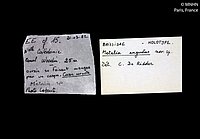

![]()
![]()
![]()




,%20detoral,%20Pléistocène,%20Hurghada,%20Egypte,%2050%20mm.jpg)
,%20apical,%20Ternopil,%20Ukraine,%20Miocène%20moyen,%2044%20mm.jpg)
,%20periprocte,%20Ternopil,%20Ukraine,%20Miocène%20moyen,%2044%20mm.jpg)
